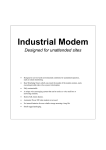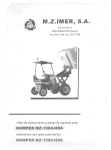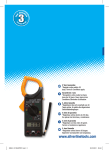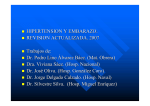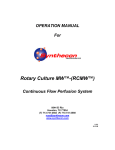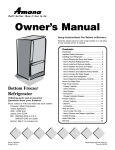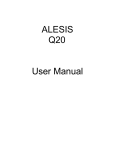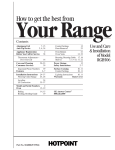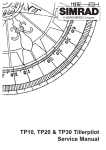Download Simrad Navico WP10 Technical data
Transcript
Manual Navico WP10 Wheelpilot E03548 Issue 1.0 CONTENTS For service and advice please contact the main Simrad dealer in your country of residence. 1. General 1.1 1.2 2. Operation 2.1 2.2 2.3 2.4 2.5 2.6 2.7 2.8 3. Scaling Calibration Mode Adjusting Gain Adjusting Seastate Installation 4.1 4.2 5. General Engaging the Clutch Autopilot Mode Adjusting Course Autotack Rudder Movement (Gain) Seastate Autotrim Configuration 3.1 3.2 3.3 3.4 4. Introduction Technical Summary Fitting Wheelpilot Electrical Installation Appendix 5.1 5.2 5.3 5.4 5.5 5.6 Advice On Operation Fault Finding Auto Compass Calibration Adjusting Belt Tension Spares & Accessories Service & Warranty © 1998 Simrad Navico Ltd The technical data, information and illustrations contained in this publication were to the best of our knowledge correct at the time of going to print. We reserve the right to change specifications, equipment, installation and maintenance instructions without notice as part of our policy of continuous development and improvement. No part of this publication may be reproduced, stored in a retrieval system or transmitted in any form, electronic or otherwise without prior permission from Simrad Navico Ltd. No liability can be accepted for any inaccuracies or omissions in the publication, although every care has been taken to make it as complete and accurate as possible. MDL 2/12/98 Page 2 Page 3 1 General 1.2 Technical Summary WHEELPILOT WP10 SPECIFICATIONS 1.1 Introduction Supply Voltage Power Consumption (Typical) The Simrad Wheelpilot WP10 is a self contained automatic pilot suitable for a wide variety of wheel steered sailing yachts up to 10M (32 Ft) in length. Combining highly sophisticated electronics with advanced software and a powerful mechanical drive, it is capable of providing reliable and accurate steering performance under a variety of different conditions with minimal current consumption. Thank you for choosing Simrad 165mm (6.5 in) 550mm (21.6in) 0 P3 W Simrad operate a policy of continual development and reserve the right to alter and improve the specification of their products without notice. 234mm (9.2 in) 0 P3 W To ensure the best results from your Wheelpilot it is essential that the unit is installed correctly. Please read this manual thoroughly before installation. 348mm (13.7 in) 388mm (15.25 in) Fig 1.1 - Wheelpilot dimensions The WP10 has been designed so that, while it represents the state of the art in marine autopilots with many advanced features, it remains very simple to operate, using only five keys to access all functions. If you are pleased with your Wheelpilot we hope you will be interested in our range of marine electronic equipment, which is manufactured to the same high standards as the Wheelpilot. Please contact your nearest Simrad Agent for a catalogue showing our increasing range of high tech navigational instruments, GPS, autopilots, Radar, Chartplotters, Fishfinders and VHF radio sets. 12v DC (10v-16v) 0.06A (Standby) 0.75A (Auto) Wheelpilot WP10 Wheelpilot¨ is a Registered Trade Mark of Simrad Navico Ltd Page 4 Page 5 2 Operation To make a 1¼ adjustment, press either the Port or Starboard key once. This is confirmed by a single beep, and the relevant Port or Starboard LED will flash once. 2.1 General Clutch Off The Wheelpilot powers up in Standby Mode, indicated by a flashing LED next to the STBY AUTO key. The two direction LEDs above the Port and Starboard keys are always dimly lit, which provides night illumination for the keypad. All functions are confirmed audibly by a ÒbeepÓ and visually by the LEDs, so the status of the unit can always be confirmed at a glance. Clutch On 2.3 Autopilot Mode To lock the vessel onto the current heading, simply steer a straight course, engage the clutch and press the STBY AUTO key to switch to Auto Mode, indicated by the LED next to the STBY AUTO key lighting permanently (Fig 2.2). The Wheelpilot has a built-in autotack facility, allowing easy tacking of the vessel when single or short handed. An autotack is only possible when in Autopilot Mode. Fig 2.1 - Engaging clutch To disengage the pilot, press the STBY AUTO key and lift the clutch lever. Always switch the pilot to Standby mode when disengaging the clutch. TACK STBY STBY STBY AUTO AUTO Fig 2.2 - Engaging autopilot mode TACK STBY STBY AUTO CAL 2.4 Adjusting Course While in Autopilot Mode, precise course adjustments can be easily made Page 6 To initiate autotack, press and hold the Tack key, followed by either the Port or Starboard key, depending on which direction you wish to tack (Fig 2.4). The WP10 has a factory preset autotack angle of 110¼. TACK TACK STBY STBY AUTO 2.6 Rudder Movement (Gain) To lock the pilot onto the desired course, simply steer the correct course and then engage the autopilot. The wheel should always be in the centreline position before engaging the Wheelpilot. If the STBY AUTO key is pressed and held, the pilot will beep a second time and lock onto the previously used heading (this feature will not be available if the unit has just been switched on). STBY STBY AUTO 2.5 Autotack 2.2 Engaging the clutch The Wheelpilot will not drive in any mode unless the drive clutch is engaged first. The clutch is controlled by the lever on the left side of the unit (Fig 2.1). When the lever is in the upward position, the clutch is disengaged, and the wheel is free to turn by hand. To engage the clutch, push the lever down fully until it is flush with the motor housing. The wheel will then be held firmly by the Wheelpilot - hand steering will not be possible until the clutch is disengaged. TACK To make a 10¼ adjustment, press and hold the key, confirmed by a double beep and a double flash of the Port or Starboard LED (Fig 2.3). The Wheelpilot uses highly advanced steering software, which constantly assesses how the vessel is being affected by the prevailing conditions. By adjusting its own performance, the pilot is able to maintain the most accurate course for these conditions, just as a human pilot would. Thus, in a rough sea the pilot is not overworked and battery drain is kept to a minimum. Fig 2.4 - Initiating Starboard autotack The pilot will make corrections to compensate for heading errors, in order to keep the boat on course. The amount of rudder correction made is set by the Gain (sometimes referred to as the rudder ratio). The Gain setting can be compared to driving a motor vehicle - at high speeds, very little wheel movement is necessary to steer the vehicle (LOW gain). When driving at slow speeds, more wheel movement is necessary (HIGH gain). Fig 2.5A shows the effect of setting the Gain too low: the boat takes a long time to return to the correct heading. Fig 2.5B is ideal, where errors are quickly corrected. Fig 2.5C occurs when the Gain too high, causing the boat to ÒSÓ, or oscillate around the correct heading. Excessive Gain (Fig 2.5D) causes instability of course, leading to increasing error. Fig 2.3 - Course adjustment to Port To adjust Gain, please refer to section 3.3. A B C D Fig 2.5 - Effects of Gain setting Page 7 2.7 Seastate The dead band is automatically set and updated by the Wheelpilot to give the best compromise between course holding and battery consumption. However, this can be manually set if so desired. To manually adjust the Seastate, please refer to section 3.4. 3 2.8 Autotrim Under differing conditions a rudder bias (sometimes known as standing helm or rudder trim) is applied in order to steer a straight course. An example is when sailing close hauled where the vessel will normally pull into the wind, and the helmsman applies a standing helm to leeward in order to maintain course. The amount of this standing helm varies according to factors such as strength of wind, boat speed, sail trim and amount of sail set. If no account of these were taken, then the vessel would tend to veer off course, or pull round head to wind if sailing close hauled. The Wheelpilot continuously monitors the average course error and applies a bias to the wheel to compensate until the optimum condition is reached. This bias or standing helm is applied gradually, so as not to upset the normal performance of the Wheelpilot. Thus, it may take up to a minute or so to fully compensate after changing tack. Once optimum trim is reached, the pilot will still monitor for changes in the prevailing conditions and update the trim accordingly. Configuration 3.1 Scaling D B A N D D E A º Average Course In rough weather, more variations in heading will be detected by the Wheelpilot due to the heavy seas yawing the vessel. If no account of this was taken, then the Wheelpilot would be overworked, causing unnecessary strain on the unit and excessive drain on the batteries. All Simrad Wheelpilots will continuously monitor corrections applied to the wheel over the course of a voyage, and allow a Òdead bandÓ within which the boat can go off course without corrections being made (Fig 2.6). Fig 2.6 - Seastate “deadband” Before using the Wheelpilot, it is necessary to program in the steering sensitivity, which is related to the number of turns that the wheel makes between end stops. This will determine the amount of steering correction the Wheelpilot applies. With the power OFF, press and hold the TACK and CAL keys and switch on the power. Both Port and Starboard LEDs will illuminate, the Cal LED will flash, and a repeated sequence of beeps will be heard. The number of flashes and beeps in the sequence indicates the current scaling factor. The scaling factor is the total number of half turns from lock to lock. For example, if the wheel has three complete turns from lock to lock, the scaling factor will be 6. If there are 11Ú2 turns from lock to lock, then the factor will be 3. Setting (No. beeps/flashes) Turns Lock To Lock 2 3 4 5 6 7 8 9 10 1 11Ú2 2 21Ú2 3 31Ú2 4 41Ú2 5 Press the Starboard key to increase the scaling factor by one, to a maximum value of 10 (= 5 turns lock to lock). Press the Port key to decrease the scaling factor by one, to a minimum value of 2 (= 1 turn lock to lock). TACK TACK STBY STBY AUTO NAV CAL POWER ON TACK STBY STBY AUTO CAL TACK STBY STBY AUTO CAL NAV Fig 3.1 - Reducing scaling factor by one To confirm scaling setting and return to Standby Mode, press the CAL key. Page 8 Page 9 3.2 Calibration Mode Press and hold the TACK key, followed by the CAL key (Fig 3.2). The Starboard LED will illuminate to indicate that the pilot is in Gain Mode. To toggle between Gain and Seastate Mode, press the TACK key (Fig 3.3). The Port LED will illuminate to indicate Seastate Mode. 4 4.1 Fitting Wheelpilot TACK TACK TACK 3.3 Adjusting Gain When Gain Mode is selected (indicated by the Starboard LED illuminated), the Cal LED will flash and a repeated sequence of beeps will be heard. The number of flashes and beeps in the sequence indicates the level of the Gain setting. To increase the Gain press the Starboard key the required number of times, to a maximum level of 9 (Fig 3.4). To decrease the Gain press the Port key the required number of times, to a minimum level of 1. For example, if the Gain was set at 4 (indicated by a sequence of four flashes of the Cal LED and four beeps), and the Gain needed to be increased to 7, pressing the Starboard key three times would adjust the Gain accordingly. The Cal LED would then flash seven times and seven beeps would be heard. 3.4 Adjusting Seastate When adjusting Seastate (indicated by the Port LED illuminated), the Seastate level is indicated by the number of audible beeps and flashes of the Cal LED. No beeps or flashes of the Cal LED indicates that the Wheelpilot is set to automatic seastate (see section 2.7). To switch from Auto to Manual Seastate and increase the Seastate level, press the Starboard key the required number of times to a maximum level of 9. To decrease the Seastate press the Port key the required number of times, to a minimum level of 0 - which will switch the Wheelpilot back to Auto Seastate. To confirm Gain/Seastate settings and return to normal operation, press the CAL key. Page 10 Installation STBY STBY AUTO NAV CAL NAV Fig 3.2 - Entering Calibration Mode TACK TACK STBY STBY AUTO Fig 3.3 - Toggling between Adjust Gain and Seastate With correct preparation, the Wheelpilot can be installed in under an hour. However, it is important that it is fitted correctly to operate to its maximum efficiency. Please read this section thoroughly before attempting installation. The fixing point of the Wheelpilot is the pedestal mount which is fixed to the pedestal using two band clamps. The Wheelpilot unit attaches to this mount using two metal guide rods which slide into slots on either side of the clamp. Thus, no holes need to be drilled to install the pilot, and it can be easily and quickly removed if necessary. The pedestal mount supplied will fit most pedestals 100 Ð 140mm (4.0 Ð 5.5 in) in diameter. Two packing pieces are supplied for use with a standard 100mm (4.0 in) pedestal (Fig 4.1). The pedestal mount has three sets of slots for the band clamps to suit the pedestal being fitted to (Fig 4.2). For pedestals over 140mm (5.5 in) diameter, a larger clamp is available as a separate accessory (part code PED200:BK). The two guide rods are not fitted to the Wheelpilot itself when supplied and will need to be attached. As these will support any loads the Wheelpilot is subjected to it is important that they are securely fitted. The ends of the rods have flats on them, which will allow a 12mm spanner to be used to tighten them (Fig 4.3). Packing pieces Fig 4.1 - Fitting to 250mm (4.0 in) pedestal Slots for band clamps Fig 4.2 - Rear view of pedestal mount Fig 4.3 - Attaching guide rods 1. Remove the wheel. TACK STBY STBY AUTO CAL Fig 3.4 - Increasing Gain level 2. Position the pedestal mount on the front of the pedestal. The vertical distance between the centres of the circular slots and the centre of the wheel shaft should be 125mm (5.0 in) and the clamp should be exactly parallel with the wheel in both planes (Fig 4.4). 3. The exposed section of the band clamps are slotted through the sleeving provided, which covers the clip and also prevents it from scratching the pedestal when tightened. It is recommended that the sleeving is cut approx 25mm (1.0in) short, to prevent it from fouling the slots in the pedestal mount through which the band clamps are fitted. 125mm (5.0 in) To adjust the Gain and Seastate settings of the Wheelpilot it is necessary to enter Calibration Mode, which can be done whilst the Wheelpilot is in either Standby or Autopilot Mode. Band clamps Pedestal Mount Fig 4.4 - Correct positioning of pedestal mount Sleeving Page 11 4. The self adhesive neoprene pad supplied should be attached to the inside face of the pedestal mount. This not only increases the grip of the pedestal mount, but also protects the pedestal from being scratched by the mount. Front Plate Spoke clamps Pedestal Mount Badge 5. Thread the band clamps through the pedestal mount (using the appropriate slots to fit the pedestal) around the pedestal and back in through the corresponding slot on the other side of the mount (Fig 4.5). 6. Tighten the band clamps as far as possible until the pedestal mount is held firmly in place and cannot be moved. Fit the front plate, but do not tighten the 4 socket head bolts at this point. 7. Fit the Wheelpilot to the pedestal mount by inserting the two guide rods into the slots on the pedestal mount. Check that the Wheelpilot ring is centralised around the wheel shaft (Fig 4.6). If necessary, reposition the pedestal mount by removing the pilot and the front plate and loosening the band clamp. Neoprene Pad Wheel nut Pedestal Fig 4.5 - Attaching clamp using band clamps Socket head bolts 8. With the clutch lever disengaged, rotate the Wheelpilot ring until the two spoke pillars are at the top. Attaching Badge 9. Refit the wheel, ensuring that the bottom spoke sits between the two spoke clamps. 10. Two rubber clamps are supplied that fit over the toothed spoke pillars. The holes in the clamps are offset so that by rotating them the gap between the pillars can be increased or decreased until the wheel spoke is held securely (Fig 4.7). 11. If necessary, move the Wheelpilot forward or back along the guide rods until the wheel spoke fits equally between the clamps. Fig 4.8 - Fitting of Wheelpilot Fig 4.6 - Pilot should be central to wheel shaft 12. Clip the Simrad badge onto the spoke clamps (Fig 4.8). The Wheelpilot is supplied with a clip on sun cover (Fig 4.9) to protect the keypad and control unit from the elements and the effects of UV light while the pilot is not in use. Apart from this cover, the Wheelpilot is fully protected from the elements due to its weatherproof design, and can be left fitted to the pedestal without requiring any additional protection. 13. Spin the wheel from lock to lock and check that the Wheelpilot rotates freely and smoothly. If there is any oscillation at any point of rotation this is due to the Wheelpilot being mounted slightly off-centre. Check that the pedestal clamp is not too low or high and that the pedestal mount and the pilot are exactly parallel to the wheel. 14. Tighten the four socket head bolts on each side of the pedestal mount so that the guide rods are held firmly in place. Do not overtighten. Page 12 Fig 4.9 - Keypad sun cover Fig 4.7 - Offset rubber spoke clamps Page 13 4.2 Electrical Installation The Wheelpilot WP10 operates from a 12v DC supply. It is designed to be permanently wired into the vesselÕs 12v supply using a two core cable. If required, a two-pin waterproof plug and socket kit is available as a separate accessory (part code SKT100). The WP10 should be wired to the 12v power supply in accordance with Fig 4.10. 5 Appendix 5.1 Advice On Operation Core. Wired To Brown +12v DC Blue * Run the cable through the pedestal using a suitable grommet. If running the cable through the deck use a good quality cable gland to prevent water ingress (Fig 4.11). The Simrad Navico Wheelpilot when used correctly can maintain as good a course, on most points of sail as a skilled helmsman, with the advantage that they never lose concentration where a human may begin to show lapses of concentration after as little as ten minutes. There are certain circumstances however, where a human pilot has the advantage in being able to anticipate events which no autopilot can sense, typically in a heavy following sea. The following advice should improve efficiency when sailing using Wheelpilot: 0v Fig 5.10 - Wiring connections - WP10 1. When sailing close to the wind, it is easy to forget to trim the mainsail, allowing excessive weather helm to build up. Where a human helmsman would quickly complain, the autopilot will struggle on, and the boat will be sailed less efficiently. Whereas a human normally likes to feel some weather helm, this is not necessary for the functioning of the Wheelpilot. Power consumption, wear and drag will be greatly reduced if the mainsail is freed or reefed a little sooner than normal when sailing manually. * Use a suitable gauge cable if an additional cable run is required to link the pilot to the power supply (see Fig 4.12). 2. It is also advisable when sailing close hauled to set a course a few degrees free of that normally sailed under manual control, to avoid luffing into the wind. * Connect to the vesselÕs switch panel via a 10 Amp fuse or breaker. 0 P3 W 3. When running dead downwind, a human pilot can see visual signs warning him if the boat is about to gybe, which the Wheelpilot cannot sense. Therefore, when under autopilot it is advisable not to sail as close to the gybe as you may do when sailing manually. * Do not fit other electronic or electrical equipment to this cable, or Òtap intoÓ the supply from a nearby cable - always wire each piece of equipment to its own breaker in the switch panel. Cable Grommet 4. When broad reaching or running fast, particularly with quartering waves, a helmsman will naturally apply periodic larger angles of helm than when beating or sailing slowly. This is the equivalent of increasing rudder Gain, and it may be a good idea to adjust the Gain on the Wheelpilot. Many people prefer to find a compromise setting which is used for all sailing, but with practice it can be optimised for different conditions e.g. low for motoring in a calm sea or high for running fast. If the Gain is set too low, the boat will yaw because insufficient rudder is applied in time; if the gain is too high, the boat will continually overcorrect on each deviation, increasing power consumption. * Ensure all wire ends are tinned, and any connections are well made. Poor contact will result in loss of torque from the Wheelpilot and slower speed of response. * If in any doubt, employ a qualified engineer to install the equipment. Brown 12v DC Blue 0v 5. While the clutch is engaged, the wheel cannot be turned manually. In an emergency situation, manual control can only be achieved by lifting the clutch lever. Do not attempt to force the wheel while the clutch is engaged as you may damage the Wheelpilot or break the internal drive belt. Fig 4.11 - Cable run Extra Cable Run Cross Conducto AW Section Area r Type G Under 4M (13Ft) 1.5mm2 4-8M (27Ft) 2.5mm2 30/0.25 16 50/0.25 Fig 4.12 - Cable selection table Page 14 6. The Wheelpilot is a highly advanced piece of equipment - as such, it is a valuable aid to enjoyable sailing. However, it would be a mistake to become complacent. As with all electronic navigational equipment, it is an aid to navigation and should not be used as a substitute for conventional navigational practice. Remember - Maritime Law* requires that you keep a good look out at all times. *IMO International Regulations for Preventing Collisions at Sea, Part B Rule 5 (1972) Page 15 5.3 Auto Compass Calibration 5.2 Fault Finding Symptom Probable Cause Pilot consistently over or * Gain setting is respectively too high under compensates when a or too low. course error is detected * Steering sensitivity scaling has been incorrectly set After functioning normally course is suddenly lost and the Wheelpilot goes into Standby Mode. Remedy * Adjust gain setting (see section 3.3). * Enter the correct scaling for the vessel (see section 3.1). * Power interrupted briefly, or low * Increase size of cable. * Check all connections. voltage. * Charge batteries. * Supply cable used too small. * Uprate batteries. * Intermittent connection. Helm is hard over and alarm is * Steerage way insufficient to control * Reset the vessel on course and re-engage pilot continuously on. course, or sails are aback. * Enter the correct scaling for * Steering scaling set too high the vessel (see section 3.1). Power supply is live, but pilot * Wheelpilot is wired incorrectly. is not on. * Check wiring of pilot (see section 4.2). Pilot does not hold accurate * Internal fluxgate compass is being course in auto mode affected by interference from nearby magnetic influences (binnacle compass, speakers) or metallic objects (winches, deck hardware etc). * Check compass has been calibrated (see section 5.3). * Replace binnacle compass with bulkhead compass. * Relocate objects that are causing interference. Although the Wheelpilot internal compass is extremely accurate, after installation it is necessary to calibrate the compass to compensate for any deviations caused by objects surrounding it on board the vessel. With the vessel motoring along slowly (2-3 knots) in calm conditions and the Wheelpilot in Standby Mode, engage the clutch and press the Starboard key a number of times to induce a slow clockwise rotation of the vessel. Press and hold the TACK key, followed by the Port and Starboard keys simultaneously to enter Auto Compass Calibration Mode (Fig 5.1). The Port and Starboard LEDs will both light. Allow the vessel to turn through a minimum of 11/4 turns (450¼) in approximately two minutes, during which time the fluxgate compass will automatically calibrate itself. If the rate of turn or the boat speed is too high, the Port LED will flash (Fig 5.2) indicating that it is necessary to either slow the boat or decrease the angle of turn. If the rate or turn or boat speed is too slow the Starboard LED will flash, indicating that it is necessary to either increase the boat speed or increase the angle of turn. A double beep will indicate that the calibration has been successful, and the Wheelpilot will return to Standby Mode. If the calibration has been unsuccessful after a period of four minutes, a long beep will sound. Try again carefully following the above directions. TACK TACK TACK Fig 5.1 - Auto Compass Calibration TACK Fig 5.2 - Rate of turn too fast 5.4 Adjusting Belt Tension The belt tension is set when the Wheelpilot is assembled, however it may be necessary to adjust this during the lifetime of the pilot. The tension is adjusted by means of a screw situated underneath the clutch lever (Fig 5.3). This screw is only accessible when the lever is in the up (disengaged) position. To increase the clutch tension, turn the screw anticlockwise. To decrease the tension, turn the screw clockwise. The scale next to the screw indicates the current tension setting. When the pointer is at the top, the clutch is at maximum tension. Minimum tension is indicated when the pointer is at the bottom. Indicator pointer Scale Adjusting screw Fig 5.3 - Belt tensioner Page 16 Page 17 5.4 Spares & Accessories The following spares and accessories are available through your local Simrad agent. Please quote the correct part number when ordering. PED200:BK Large Pedestal Mount kit for pedestals 175 to 200mm dia (7.0 to 8.0 in). SKT100 2-Way Waterproof Plug and Socket kit E03011 Spare spoke clamps (supplied individually) E03529 E03235 Replacement badge Extra long guide rods 5.5 Service & Warranty Your Wheelpilot should seldom need servicing, but will benefit from an application of silicone or Teflon grease to the connectors each season, and by keeping the control unit protective cover in place when not in use. The unit is guaranteed for 12 months from date of retail sale. If it is necessary to have the unit repaired, return it carriage prepaid to the agent in the country of purchase with a copy of the receipted invoice showing the date of purchase. Where possible, return all the components unless you are certain that you have located the source of the fault. If the original packing is not available, ensure that it is well cushioned in packing; the rigours of freight handling can be very different from the loads encountered in the marine environment for which the unit is designed. For Worldwide Warranty details, please refer to the Warranty Card supplied with this unit. A list of official worldwide Simrad dealers is included in the Warranty Card. Page 18 Manufacturer: Simrad Navico Star Lane, Margate Kent CT9 4NP United Kingdom Telephone: +44 (0) 1843 290290 Telefax: +44 (0) 1843 290471 E-Mail: simrad-navico.co.uk WORLDWIDE MANUFACTURER OF MARINE ELECTRONICS













